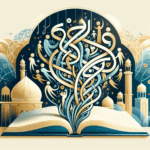The Arabic Alphabet in Literature: Classic and Contemporary Works
The Arabic alphabet, with its flowing script and rich history, has been a cornerstone of literature for centuries. From ancient poetic expressions to modern literary masterpieces, Arabic scripts have played an essential role in shaping the cultural and intellectual landscape. Let’s delve into the fascinating journey of the Arabic alphabet in literature, exploring both classic and contemporary works.
Table of Contents
1. Introduction to the Arabic Alphabet
2. The Role of the Arabic Alphabet in Classic Literature 📜
3. The Influence of the Arabic Alphabet on Contemporary Works 📚
4. Conclusion: The Timelessness of Arabic Script
5. FAQs
Introduction to the Arabic Alphabet
The Arabic alphabet consists of 28 letters and is written from right to left. Its aesthetic appeal and complex calligraphy have made it a favorite among writers and artists alike. As the script of the Quran, it holds a significant place in Islamic culture and beyond.
The Role of the Arabic Alphabet in Classic Literature 📜
In classic literature, the Arabic alphabet was more than just a set of characters; it was a vehicle for expression and a tool for preserving history. Notable works such as „One Thousand and One Nights“ and the poetry of Al-Mutanabbi are testaments to the beauty and depth of Arabic writing. These works not only entertained but also provided insights into the social and political climates of their times.
During the Golden Age of Islam, literature thrived, with scholars and poets exploring themes of love, philosophy, and religion. The intricate calligraphy and eloquent prose of this era have left a lasting legacy on the world of literature.
The Influence of the Arabic Alphabet on Contemporary Works 📚
In the contemporary literary scene, the Arabic alphabet continues to inspire and influence. Modern authors like Naguib Mahfouz and Hanan al-Shaykh have embraced the script to tell stories that resonate with today’s readers. Their works often bridge the gap between tradition and modernity, exploring themes such as identity, gender, and politics.
The digital age has also seen the Arabic alphabet adapt to new mediums, with e-books and online publications making literature more accessible than ever. Social media platforms have become a space where writers experiment with the script, pushing the boundaries of traditional storytelling.
Conclusion: The Timelessness of Arabic Script
The Arabic alphabet is more than a collection of letters; it is a symbol of cultural heritage and a tool for artistic expression. Whether in classic poetry or contemporary novels, its influence remains profound and enduring. As we continue to explore and appreciate the richness of Arabic literature, the alphabet will undoubtedly remain at its core, inspiring generations to come.
FAQs
1. Why is the Arabic alphabet significant in literature?
The Arabic alphabet is significant because it serves as a cultural and historical bridge, preserving stories and ideas across generations.
2. How has the Arabic alphabet evolved in modern literature?
In modern literature, the Arabic alphabet has adapted to digital formats and been used to explore contemporary themes like identity and globalization.
3. Who are some notable contemporary authors using the Arabic alphabet?
Authors like Naguib Mahfouz and Hanan al-Shaykh are renowned for their use of the Arabic alphabet in modern storytelling.
4. What role does calligraphy play in Arabic literature?
Calligraphy enhances the visual appeal of Arabic literature, adding an artistic dimension that complements the written word.
5. How accessible is Arabic literature today?
With the rise of digital platforms and translations, Arabic literature is more accessible to a global audience than ever before.





